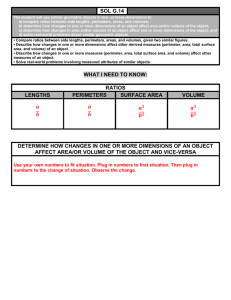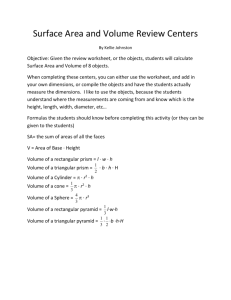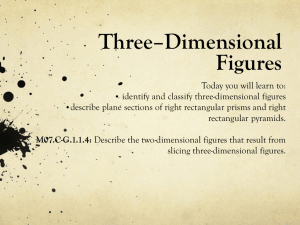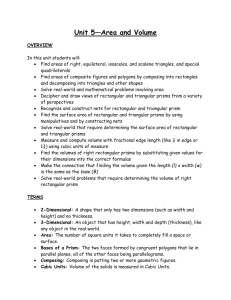Because the lateral faces
advertisement
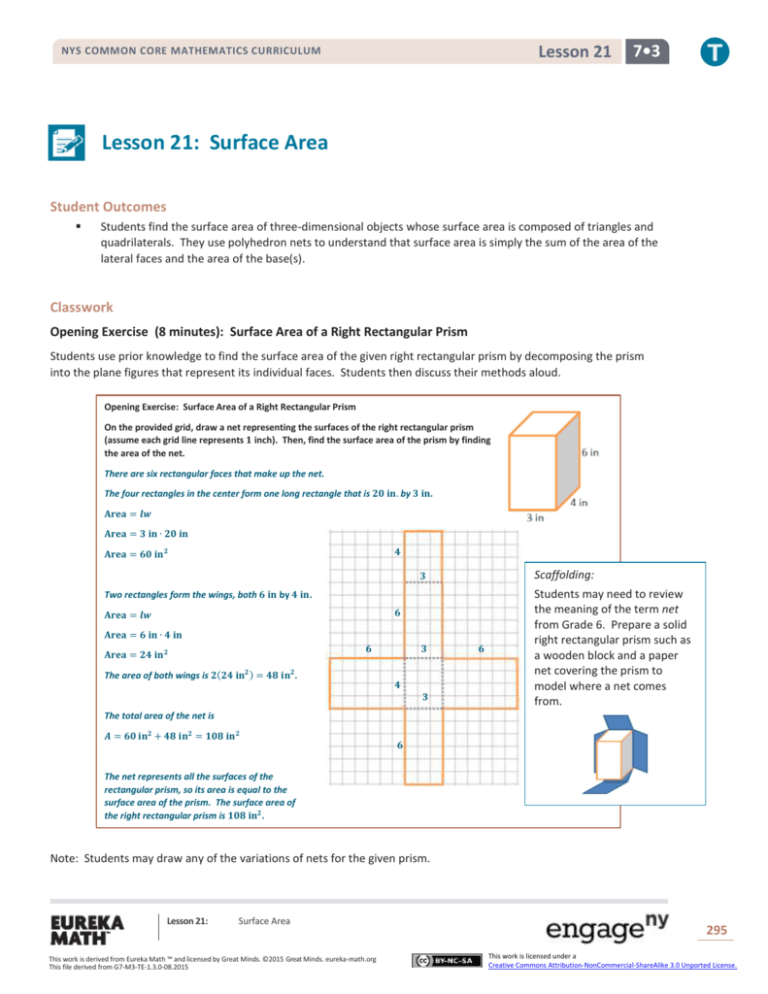
Lesson 21 NYS COMMON CORE MATHEMATICS CURRICULUM 7•3 Lesson 21: Surface Area Student Outcomes Students find the surface area of three-dimensional objects whose surface area is composed of triangles and quadrilaterals. They use polyhedron nets to understand that surface area is simply the sum of the area of the lateral faces and the area of the base(s). Classwork Opening Exercise (8 minutes): Surface Area of a Right Rectangular Prism Students use prior knowledge to find the surface area of the given right rectangular prism by decomposing the prism into the plane figures that represent its individual faces. Students then discuss their methods aloud. Opening Exercise: Surface Area of a Right Rectangular Prism On the provided grid, draw a net representing the surfaces of the right rectangular prism (assume each grid line represents 𝟏 inch). Then, find the surface area of the prism by finding the area of the net. There are six rectangular faces that make up the net. The four rectangles in the center form one long rectangle that is 𝟐𝟎 𝐢𝐧. by 𝟑 𝐢𝐧. 𝐀𝐫𝐞𝐚 = 𝒍𝒘 𝐀𝐫𝐞𝐚 = 𝟑 𝐢𝐧 ∙ 𝟐𝟎 𝐢𝐧 𝟒 𝐀𝐫𝐞𝐚 = 𝟔𝟎 𝐢𝐧𝟐 𝟑 Scaffolding: 𝟑 Students may need to review the meaning of the term net from Grade 6. Prepare a solid right rectangular prism such as a wooden block and a paper net covering the prism to model where a net comes from. Two rectangles form the wings, both 𝟔 𝐢𝐧 by 𝟒 𝐢𝐧. 𝟔 𝐀𝐫𝐞𝐚 = 𝒍𝒘 𝐀𝐫𝐞𝐚 = 𝟔 𝐢𝐧 ∙ 𝟒 𝐢𝐧 𝟔 𝐀𝐫𝐞𝐚 = 𝟐𝟒 𝐢𝐧𝟐 The area of both wings is 𝟐(𝟐𝟒 𝐢𝐧𝟐 ) = 𝟒𝟖 𝐢𝐧𝟐 . 𝟒 𝟑 𝟔 The total area of the net is 𝑨 = 𝟔𝟎 𝐢𝐧𝟐 + 𝟒𝟖 𝐢𝐧𝟐 = 𝟏𝟎𝟖 𝐢𝐧𝟐 𝟔 The net represents all the surfaces of the rectangular prism, so its area is equal to the surface area of the prism. The surface area of the right rectangular prism is 𝟏𝟎𝟖 𝐢𝐧𝟐 . Note: Students may draw any of the variations of nets for the given prism. Lesson 21: Surface Area This work is derived from Eureka Math ™ and licensed by Great Minds. ©2015 Great Minds. eureka-math.org This file derived from G7-M3-TE-1.3.0-08.2015 295 This work is licensed under a Creative Commons Attribution-NonCommercial-ShareAlike 3.0 Unported License. Lesson 21 NYS COMMON CORE MATHEMATICS CURRICULUM 7•3 Discussion (3 minutes) What other ways could we have found the surface area of the rectangular prism? Surface area formula: 𝑆𝐴 = 2𝑙𝑤 + 2𝑙ℎ + 2𝑤ℎ 𝑆𝐴 = 2(3 in ∙ 4 in) + 2(3 in ∙ 6 in) + 2(4 in ∙ 6 in) 𝑆𝐴 = 24 in2 + 36 in2 + 48 in2 𝑆𝐴 = 108 in2 Find the areas of each individual rectangular face: Side rectangle Front rectangle Top rectangle 4 in 6 in 6 in 3 in 4 in 3 in Area = length × width 𝐴 = 6 in × 3 in 2 𝐴 = 18 in There are two of each face, so 𝐴 = 4 in × 3 in 𝐴 = 6 in × 4 in 2 𝐴 = 24 in2 𝐴 = 12 in 2 2 𝑆𝐴 = 2(18 in + 12 in + 24 in2 ) 𝑆𝐴 = 2(54 in2 ) 𝑆𝐴 = 108 in2 . Discussion (6 minutes): Terminology A right prism can be described as a solid with two “end” faces (called its bases) that are exact copies of each other and rectangular faces that join corresponding edges of the bases (called lateral faces). Are the bottom and top faces of a right rectangular prism the bases of the prism? 6 in If we slice the right rectangular prism in half along a diagonal of a base (see picture), the two halves are called right triangular prisms. Why do you think they are called triangular prisms? 5 in Not always. Any of its opposite faces can be considered bases because they are all rectangles. The bases of each prism are triangles, and prisms are named by their bases. 4 in 3 in Why must the triangular faces be the bases of these prisms? Because the lateral faces (faces that are not bases) of a right prism have to be rectangles. Lesson 21: Surface Area This work is derived from Eureka Math ™ and licensed by Great Minds. ©2015 Great Minds. eureka-math.org This file derived from G7-M3-TE-1.3.0-08.2015 296 This work is licensed under a Creative Commons Attribution-NonCommercial-ShareAlike 3.0 Unported License. NYS COMMON CORE MATHEMATICS CURRICULUM Lesson 21 7•3 Can the surface area formula for a right rectangular prism (𝑆𝐴 = 2𝑙𝑤 + 2𝑙ℎ + 2𝑤ℎ) be applied to find the surface area of a right triangular prism? Why or why not? No, because each of the terms in the surface area formula represents the area of a rectangular face. A right triangular prism has bases that are triangular, not rectangular. Exercise 1 (8 minutes) Students find the surface area of the right triangular prism to determine the validity of a given conjecture. Exercise 1 Marcus thinks that the surface area of the right triangular prism will be half that of the right rectangular prism and wants to use the modified formula 𝑺𝑨 = 𝟏 (𝟐𝒍𝒘 + 𝟐𝒍𝒉 + 𝟐𝒘𝒉). Do you agree or disagree with Marcus? Use nets of the prisms 𝟐 to support your argument. The surface area of the right rectangular prism is 𝟏𝟎𝟖 𝐢𝐧𝟐 , so Marcus believes the surface areas of each right triangular prism is 𝟓𝟒 𝐢𝐧𝟐 . Students can make comparisons of the area values depicted in the nets of the prisms and can also compare the physical areas of the nets either by overlapping the nets on the same grid or using a transparent overlay. The net of the right triangular prism has one less face than the right rectangular prism. Two of the rectangular faces on the right triangular prism (rectangular regions 1 and 2 in the diagram) are the same faces from the right rectangular prism, so they are the same size. The areas of the triangular bases (triangular regions 3 and 4 in the diagram) are half the area of their corresponding rectangular faces of the right rectangular prism. These four faces of the right triangular prism make up half the surface area of the right rectangular prism before considering the fifth face; no, Marcus is incorrect. MP.3 The areas of rectangular faces 1 and 2, plus the areas of the triangular regions 3 and 4 is 𝟓𝟒 𝐢𝐧𝟐 . The last rectangular region has an area of 𝟑𝟎 𝐢𝐧𝟐 . The total area of the net is 𝟓𝟒 𝐢𝐧𝟐 + 𝟑𝟎 𝐢𝐧𝟐 or 𝟖𝟒 𝐢𝐧𝟐 , which is far more than half the surface area of the right rectangular prism. Use a transparency to show students how the nets overlap where the lateral faces together form a longer rectangular region, and the bases are represented by “wings” on either side of that triangle. Consider using student work for this if there is a good example. Use this setup in the following discussion. Discussion (5 minutes) The surface area formula (𝑆𝐴 = 2𝑙𝑤 + 2𝑙ℎ + 2𝑤ℎ) for a right rectangular prism cannot be applied to a right triangular prism. Why? The formula adds the areas of six rectangular faces. A right triangular prism only has three rectangular faces and also has two triangular faces (bases). Lesson 21: Surface Area This work is derived from Eureka Math ™ and licensed by Great Minds. ©2015 Great Minds. eureka-math.org This file derived from G7-M3-TE-1.3.0-08.2015 297 This work is licensed under a Creative Commons Attribution-NonCommercial-ShareAlike 3.0 Unported License. Lesson 21 NYS COMMON CORE MATHEMATICS CURRICULUM 7•3 1 The area formula for triangles is the formula for the area of rectangles or parallelograms. Can the surface 2 area of a triangular prism be obtained by dividing the surface area formula for a right rectangular prism by 2? Explain. No. The right triangular prism in the above example had more than half the surface area of the right rectangular prism that it was cut from. If this occurs in one case, then it must occur in others as well. If you compare the nets of the right rectangular prism and the right triangular prism, what do the nets seem to have in common? (Hint: What do all right prisms have in common? Answer: Rectangular lateral faces) Their lateral faces form a larger rectangular region, and the bases are attached to the side of that rectangle like “wings.” Will this commonality always exist in right prisms? How do you know? Yes. Right prisms must have rectangular lateral faces. If we align all the lateral faces of a right prism in a net, they can always form a larger rectangular region because they all have the same height as the prism. How do we determine the total surface area of the prism? Add the total area of the lateral faces and the areas of the bases. If we let 𝐿𝐴 represent the lateral area and let 𝐵 represent the area of a base, then the surface area of a right prism can be found using the formula: Scaffolding: The teacher may need to assist students in finding the commonality between the nets of right prisms by showing examples of various right prisms and pointing out the fact that they all have rectangular lateral faces. The rectangular faces may be described as “connectors” between the bases of a right prism. 𝑆𝐴 = 𝐿𝐴 + 2𝐵. Example 1 (6 minutes): Lateral Area of a Right Prism Students find the lateral areas of right prisms and recognize the pattern of multiplying the height of the right prism (the distance between its bases) by the perimeter of the prism’s base. Example 1: Lateral Area of a Right Prism A right triangular prism, a right rectangular prism, and a right pentagonal prism are pictured below, and all have equal heights of 𝒉. MP.8 a. Write an expression that represents the lateral area of the right triangular prism as the sum of the areas of its lateral faces. 𝒂∙𝒉+𝒃∙𝒉+𝒄∙𝒉 b. Write an expression that represents the lateral area of the right rectangular prism as the sum of the areas of its lateral faces. 𝒂∙𝒉+𝒃∙𝒉+𝒂∙𝒉+𝒃∙𝒉 Lesson 21: Surface Area This work is derived from Eureka Math ™ and licensed by Great Minds. ©2015 Great Minds. eureka-math.org This file derived from G7-M3-TE-1.3.0-08.2015 298 This work is licensed under a Creative Commons Attribution-NonCommercial-ShareAlike 3.0 Unported License. Lesson 21 NYS COMMON CORE MATHEMATICS CURRICULUM c. 7•3 Write an expression that represents the lateral area of the right pentagonal prism as the sum of the areas of its lateral faces. 𝒂∙𝒉+𝒃∙𝒉+𝒄∙𝒉+𝒅∙𝒉+𝒆∙𝒉 d. Scaffolding: What value appears often in each expression and why? 𝒉; Each prism has a height of 𝒉; therefore, each lateral face has a height of h. e. Rewrite each expression in factored form using the distributive property and the height of each lateral face. 𝒉(𝒂 + 𝒃 + 𝒄) 𝒉(𝒂 + 𝒃 + 𝒂 + 𝒃) 𝒉(𝒂 + 𝒃 + 𝒄 + 𝒅 + 𝒆) MP.8 f. What do the parentheses in each case represent with respect to the right prisms? 𝐩𝐞𝐫𝐢𝐦𝐞𝐭𝐞𝐫 (𝒂 + 𝒃 + 𝒄) 𝒉⏞ 𝐩𝐞𝐫𝐢𝐦𝐞𝐭𝐞𝐫 (𝒂 + 𝒃 + 𝒂 + 𝒃) 𝒉⏞ The perimeter of the base of the corresponding prism. g. 𝐩𝐞𝐫𝐢𝐦𝐞𝐭𝐞𝐫 (𝒂 + 𝒃 + 𝒄 + 𝒅 + 𝒆) 𝒉⏞ Example 1 can be explored further by assigning numbers to represent the lengths of the sides of the bases of each prism. If students represent the lateral area as the sum of the areas of the lateral faces without evaluating, the common factor in each term will be evident and can then be factored out to reveal the same relationship. How can we generalize the lateral area of a right prism into a formula that applies to all right prisms? If 𝑳𝑨 represents the lateral area of a right prism, 𝑷 represents the perimeter of the right prism’s base, and 𝒉 represents the distance between the right prism’s bases, then: 𝑳𝑨 = 𝑷𝐛𝐚𝐬𝐞 ∙ 𝒉. Closing (5 minutes) The vocabulary below contains the precise definitions of the visual and colloquial descriptions used in the lesson. Please read through the definitions aloud with your students, asking questions that compare the visual and colloquial descriptions used in the lesson with the precise definitions. Relevant Vocabulary RIGHT PRISM: Let 𝑬 and 𝑬′ be two parallel planes. Let 𝑩 be a triangular or rectangular region or a region that is the union of such regions in the plane 𝑬. At each point 𝑷 of 𝑩, consider the segment 𝑷𝑷′ perpendicular to 𝑬, joining 𝑷 to a point 𝑷′ of the plane 𝑬′. The union of all these segments is a solid called a right prism. There is a region 𝑩′ in 𝑬′ that is an exact copy of the region 𝑩. The regions 𝑩 and 𝑩′ are called the base faces (or just bases) of the prism. The rectangular regions between two corresponding sides of the bases are called lateral faces of the prism. In all, the boundary of a right rectangular prism has 𝟔 faces: 𝟐 base faces and 𝟒 lateral faces. All adjacent faces intersect along segments called edges (base edges and lateral edges). Lesson 21: Surface Area This work is derived from Eureka Math ™ and licensed by Great Minds. ©2015 Great Minds. eureka-math.org This file derived from G7-M3-TE-1.3.0-08.2015 299 This work is licensed under a Creative Commons Attribution-NonCommercial-ShareAlike 3.0 Unported License. Lesson 21 NYS COMMON CORE MATHEMATICS CURRICULUM 7•3 CUBE: A cube is a right rectangular prism all of whose edges are of equal length. SURFACE: The surface of a prism is the union of all of its faces (the base faces and lateral faces). NET: A net is a two-dimensional diagram of the surface of a prism. 1. Why are the lateral faces of right prisms always rectangular regions? Because along a base edge, the line segments 𝑷𝑷′ are always perpendicular to the edge, forming a rectangular region. 2. What is the name of the right prism whose bases are rectangles? Right rectangular prism 3. How does this definition of right prism include the interior of the prism? The union of all the line segments fills out the interior. Lesson Summary The surface area of a right prism can be obtained by adding the areas of the lateral faces to the area of the bases. The formula for the surface area of a right prism is 𝑺𝑨 = 𝑳𝑨 + 𝟐𝑩, where 𝑺𝑨 represents the surface area of the prism, 𝑳𝑨 represents the area of the lateral faces, and 𝑩 represents the area of one base. The lateral area 𝑳𝑨 can be obtained by multiplying the perimeter of the base of the prism times the height of the prism. Exit Ticket (4 minutes) Lesson 21: Surface Area This work is derived from Eureka Math ™ and licensed by Great Minds. ©2015 Great Minds. eureka-math.org This file derived from G7-M3-TE-1.3.0-08.2015 300 This work is licensed under a Creative Commons Attribution-NonCommercial-ShareAlike 3.0 Unported License. Lesson 21 NYS COMMON CORE MATHEMATICS CURRICULUM Name 7•3 Date Lesson 21: Surface Area Exit Ticket Find the surface area of the right trapezoidal prism. Show all necessary work. Lesson 21: Surface Area This work is derived from Eureka Math ™ and licensed by Great Minds. ©2015 Great Minds. eureka-math.org This file derived from G7-M3-TE-1.3.0-08.2015 301 This work is licensed under a Creative Commons Attribution-NonCommercial-ShareAlike 3.0 Unported License. Lesson 21 NYS COMMON CORE MATHEMATICS CURRICULUM 7•3 Exit Ticket Sample Solutions Find the surface area of the right trapezoidal prism. Show all necessary work. 𝑺𝑨 = 𝑳𝑨 + 𝟐𝑩 𝑳𝑨 = 𝑷 ∙ 𝒉 𝑳𝑨 = (𝟑 𝐜𝐦 + 𝟕 𝐜𝐦 + 𝟓 𝐜𝐦 + 𝟏𝟏 𝐜𝐦 ) ∙ 𝟔 𝐜𝐦 𝑳𝑨 = 𝟐𝟔 𝐜𝐦 ∙ 𝟔 𝐜𝐦 𝑳𝑨 = 𝟏𝟓𝟔 𝐜𝐦𝟐 Each base consists of a 𝟑 𝐜𝐦 by 𝟕 𝐜𝐦 rectangle and right triangle with a base of 𝟑 𝐜𝐦 and a height of 𝟒 𝐜𝐦. Therefore, the area of each base: 𝑩 = 𝑨𝒓 + 𝑨𝒕 𝟏 𝟐 𝑩 = 𝒍𝒘 + 𝒃𝒉 𝟏 𝟐 𝑩 = (𝟕 𝐜𝐦 ∙ 𝟑 𝐜𝐦) + ( ∙ 𝟑 𝐜𝐦 ∙ 𝟒 𝐜𝐦) 𝑩 = 𝟐𝟏 𝐜𝐦𝟐 + 𝟔 𝐜𝐦𝟐 𝑩 = 𝟐𝟕 𝐜𝐦𝟐 𝑺𝑨 = 𝑳𝑨 + 𝟐𝑩 𝑺𝑨 = 𝟏𝟓𝟔 𝐜𝐦𝟐 + 𝟐(𝟐𝟕 𝐜𝐦𝟐 ) 𝑺𝑨 = 𝟏𝟓𝟔 𝐜𝐦𝟐 + 𝟓𝟒 𝐜𝐦𝟐 𝑺𝑨 = 𝟐𝟏𝟎 𝐜𝐦𝟐 The surface of the right trapezoidal prism is 𝟐𝟏𝟎 𝐜𝐦𝟐. Problem Set Sample Solutions 1. For each of the following nets, highlight the perimeter of the lateral area, draw the solid represented by the net, indicate the type of solid, and then find the solid’s surface area. a. Right rectangular prism 𝑺𝑨 = 𝑳𝑨 + 𝟐𝑩 𝑳𝑨 = 𝑷 ∙ 𝒉 𝑳𝑨 = (𝟐 𝑩 = 𝒍𝒘 𝟏 𝟏 𝟏 𝟏 𝐜𝐦 + 𝟕 𝐜𝐦 + 𝟐 𝐜𝐦 + 𝟕 𝐜𝐦) ∙ 𝟓 𝐜𝐦 𝟐 𝟐 𝟐 𝟐 𝑩=𝟐 𝟓 𝟐 𝟏 𝟏 𝐜𝐦 ∙ 𝟕 𝐜𝐦 𝟐 𝟐 𝑳𝑨 = 𝟐𝟎 𝐜𝐦 ∙ 𝟓 𝐜𝐦 𝑩 = 𝐜𝐦 ∙ 𝑳𝑨 = 𝟏𝟎𝟎 𝐜𝐦𝟐 𝑩= 𝑺𝑨 = 𝟏𝟎𝟎 𝐜𝐦𝟐 + 𝟐 ( 𝟏𝟓 𝐜𝐦 𝟐 𝟕𝟓 𝐜𝐦𝟐 𝟒 𝟕𝟓 𝐜𝐦𝟐 ) 𝟒 𝑺𝑨 = 𝟏𝟎𝟎 𝐜𝐦𝟐 + 𝟑𝟕. 𝟓 𝐜𝐦𝟐 𝑺𝑨 = 𝟏𝟑𝟕. 𝟓 𝐜𝐦𝟐 The surface area of the right rectangular prism is 𝟏𝟑𝟕. 𝟓 𝐜𝐦𝟐 (3-Dimensional Form) Lesson 21: Surface Area This work is derived from Eureka Math ™ and licensed by Great Minds. ©2015 Great Minds. eureka-math.org This file derived from G7-M3-TE-1.3.0-08.2015 302 This work is licensed under a Creative Commons Attribution-NonCommercial-ShareAlike 3.0 Unported License. Lesson 21 NYS COMMON CORE MATHEMATICS CURRICULUM b. 7•3 Right triangular prism 𝑺𝑨 = 𝑳𝑨 + 𝟐𝑩 𝟏 𝟐 𝑳𝑨 = 𝑷 ∙ 𝒉 𝑩 = 𝒃𝒉 𝑳𝑨 = (𝟏𝟎 𝐢𝐧. + 𝟖 𝐢𝐧. + 𝟏𝟎 𝐢𝐧. ) ∙ 𝟏𝟐 𝐢𝐧. 𝑩 = (𝟖 𝐢𝐧. ) (𝟗 𝑳𝑨 = 𝟐𝟖 𝐢𝐧.∙ 𝟏𝟐 𝐢𝐧. 𝑩 = 𝟒 𝐢𝐧. (𝟗 𝑳𝑨 = 𝟑𝟑𝟔 𝐢𝐧𝟐 𝑩 = (𝟑𝟔 + ) 𝐢𝐧𝟐 𝟏 𝟐 𝟏 𝐢𝐧. ) 𝟓 𝟏 𝐢𝐧. ) 𝟓 𝟒 𝟓 𝑩 = 𝟑𝟔 𝑺𝑨 = 𝟑𝟑𝟔 𝒊𝒏𝟐 + 𝟐 (𝟑𝟔 𝟒 𝟐 𝐢𝐧 𝟓 𝟒 𝟐 𝒊𝒏 ) 𝟓 𝟖 𝟓 𝑺𝑨 = 𝟑𝟑𝟔 𝒊𝒏𝟐 + (𝟕𝟐 + ) 𝒊𝒏𝟐 𝟑 𝟓 𝑺𝑨 = 𝟒𝟎𝟖 𝒊𝒏𝟐 + 𝟏 𝒊𝒏𝟐 𝑺𝑨 = 𝟒𝟎𝟗 𝟑 𝟐 𝒊𝒏 𝟓 The surface area of the right triangular prism is 𝟒𝟎𝟗 2. Given a cube with edges that are a. 𝟑 𝟐 𝒊𝒏 . 𝟓 (3-Dimensional Form) 𝟑 inch long: 𝟒 Find the surface area of the cube. 𝑺𝑨 = 𝟔𝒔𝟐 𝟐 𝟑 𝑺𝑨 = 𝟔 ( 𝐢𝐧. ) 𝟒 𝟑 𝟑 𝑺𝑨 = 𝟔 ( 𝐢𝐧. ) ∙ ( 𝐢𝐧. ) 𝟒 𝟒 𝟗 𝟐 𝑺𝑨 = 𝟔 ( 𝐢𝐧 ) 𝟏𝟔 𝟐𝟕 𝟐 𝟑 𝑺𝑨 = 𝐢𝐧 or 𝟑 𝐢𝐧𝟐 𝟖 𝟖 b. Joshua makes a scale drawing of the cube using a scale factor of 𝟒. Find the surface area of the cube that Joshua drew. 𝟑 𝟒 𝒊𝒏.∙ 𝟒 = 𝟑 𝒊𝒏.; The edge lengths of Joshua’s drawing would be 𝟑 inches. 𝑺𝑨 = 𝟔(𝟑 𝒊𝒏. )𝟐 𝑺𝑨 = 𝟔(𝟗 𝒊𝒏𝟐 ) 𝑺𝑨 = 𝟓𝟒 𝒊𝒏𝟐 Lesson 21: Surface Area This work is derived from Eureka Math ™ and licensed by Great Minds. ©2015 Great Minds. eureka-math.org This file derived from G7-M3-TE-1.3.0-08.2015 303 This work is licensed under a Creative Commons Attribution-NonCommercial-ShareAlike 3.0 Unported License. Lesson 21 NYS COMMON CORE MATHEMATICS CURRICULUM c. 7•3 What is the ratio of the surface area of the scale drawing to the surface area of the actual cube, and how does the value of the ratio compare to the scale factor? 𝟓𝟒 ÷ 𝟑 𝟓𝟒 ÷ 𝟓𝟒 ∙ 𝟑 𝟖 𝟐𝟕 𝟖 𝟖 𝟐𝟕 𝟐 ∙ 𝟖 = 𝟏𝟔. The ratios of the surface area of the scale drawing to the surface area of the actual cube is 𝟏𝟔: 𝟏. The value of the ratio is 𝟏𝟔. The scale factor of the drawing is 𝟒, and the value of the ratio of the surface area of the drawing to the surface area of the actual cube is 𝟒𝟐 or 𝟏𝟔. 3. Find the surface area of each of the following right prisms using the formula 𝑺𝑨 = 𝑳𝑨 + 𝟐𝑩. a. 𝑺𝑨 = 𝑳𝑨 + 𝟐𝑩 𝑳𝑨 = 𝑷 ∙ 𝒉 𝑳𝑨 = (𝟏𝟐 𝟏 𝟏 𝐦𝐦 + 𝟏𝟎 𝐦𝐦 + 𝟕 𝐦𝐦) ∙ 𝟏𝟓 𝐦𝐦 𝟐 𝟐 𝑳𝑨 = 𝟑𝟎 𝐦𝐦 ∙ 𝟏𝟓 𝐦𝐦 𝑳𝑨 = 𝟒𝟓𝟎 𝐦𝐦𝟐 𝟏 𝟐 𝟏𝟐 mm 𝟏 𝟐 𝑺𝑨 = 𝟒𝟓𝟎 𝐦𝐦𝟐 + 𝟐 ( 𝑩= 𝟏 𝟏 ∙ (𝟕 𝐦𝐦) ∙ (𝟏𝟎 𝐦𝐦) 𝟐 𝟐 𝑺𝑨 = 𝟒𝟓𝟎 𝐦𝐦𝟐 + 𝟕𝟓 𝐦𝐦𝟐 𝑩= 𝟏 ∙ (𝟕𝟎 + 𝟓) 𝐦𝐦𝟐 𝟐 𝑺𝑨 = 𝟓𝟐𝟓 𝐦𝐦𝟐 𝑩= 𝟏 ∙ 𝟕𝟓 𝐦𝐦𝟐 𝟐 𝑩= 𝟕𝟓 𝐦𝐦𝟐 𝟐 𝑩 = 𝒃𝒉 𝟕𝟓 𝐦𝐦𝟐 ) 𝟐 The surface area of the prism is 𝟓𝟐𝟓 𝐦𝐦𝟐. Lesson 21: Surface Area This work is derived from Eureka Math ™ and licensed by Great Minds. ©2015 Great Minds. eureka-math.org This file derived from G7-M3-TE-1.3.0-08.2015 304 This work is licensed under a Creative Commons Attribution-NonCommercial-ShareAlike 3.0 Unported License. Lesson 21 NYS COMMON CORE MATHEMATICS CURRICULUM 7•3 b. 𝑺𝑨 = 𝑳𝑨 + 𝟐𝑩 𝟏 𝟐 𝑳𝑨 = 𝑷 ∙ 𝒉 𝑩 = 𝒃𝒉 𝟑 𝟏 𝒊𝒏. +𝟔 𝒊𝒏. +𝟒 𝒊𝒏. ) ∙ 𝟓 𝒊𝒏 𝟐𝟓 𝟐 𝑩= 𝟏 𝟑 𝟏 ∙ 𝟗 𝒊𝒏.∙ 𝟐 𝒊𝒏. 𝟐 𝟐𝟓 𝟐 𝑳𝑨 = ( 𝟐𝟐𝟖 𝟏𝟑 𝒊𝒏. + 𝒊𝒏. +𝟒 𝒊𝒏. ) ∙ 𝟓 𝒊𝒏 𝟐𝟓 𝟐 𝑩= 𝟏 𝟐𝟐𝟖 𝟓 ∙ 𝒊𝒏.∙ 𝒊𝒏. 𝟐 𝟐𝟓 𝟐 𝑳𝑨 = ( 𝟒𝟓𝟔 𝟑𝟐𝟓 𝟐𝟎𝟎 𝒊𝒏. + 𝒊𝒏. + 𝒊𝒏. ) ∙ 𝟓 𝒊𝒏. 𝟓𝟎 𝟓𝟎 𝟓𝟎 𝑩= 𝟏,𝟏𝟒𝟎 2 𝒊𝒏 𝟏𝟎𝟎 𝑳𝑨 = ( 𝟗𝟖𝟏 𝒊𝒏. ) ∙ 𝟓 𝒊𝒏. 𝟓𝟎 𝑩 = 𝟏𝟏 𝒊𝒏2 𝑳𝑨 = (𝟗 𝑳𝑨 = 𝟐 𝟓 𝟒𝟗,𝟎𝟓𝟎 𝟐 𝒊𝒏 𝟓𝟎 𝑳𝑨 = 𝟗𝟖 𝟐 𝟓 𝟐𝑩 = 𝟐 ∙ 𝟏𝟏 𝒊𝒏𝟐 𝟏 𝒊𝒏𝟐 𝟏𝟎 𝟒 𝟓 𝟐𝑩 = 𝟐𝟐 𝒊𝒏𝟐 𝑺𝑨 = 𝑳𝑨 + 𝟐𝑩 𝑺𝑨 = 𝟗𝟖 𝟏 𝟒 𝐢𝐧𝟐 + 𝟐𝟐 𝐢𝐧𝟐 𝟏𝟎 𝟓 𝑺𝑨 = 𝟏𝟐𝟎 𝟗 𝐢𝐧𝟐 𝟏𝟎 The surface area of the prism is 𝟏𝟐𝟎 𝟗 𝐢𝐧𝟐 . 𝟏𝟎 c. 𝑺𝑨 = 𝑳𝑨 + 𝟐𝑩 𝑳𝑨 = 𝑷 ∙ 𝒉 𝟏 𝟏 𝟏 𝟏 𝟏 𝟏 𝑳𝑨 = ( 𝐢𝐧. + 𝐢𝐧. + 𝐢𝐧. + 𝐢𝐧. + 𝐢𝐧. + 𝐢𝐧. ) ∙ 𝟐 𝐢𝐧. 𝟖 𝟐 𝟖 𝟒 𝟐 𝟒 𝑳𝑨 = (𝟏 𝟑 𝐢𝐧. ) ∙ 𝟐 𝐢𝐧. 𝟒 𝑳𝑨 = 𝟐 𝐢𝐧𝟐 + 𝟏 𝑳𝑨 = 𝟑 𝟏 𝟐 𝐢𝐧 𝟐 𝟏 𝟐 𝐢𝐧 𝟐 𝑩 = 𝑨𝒓𝒆𝒄𝒕𝒂𝒏𝒈𝒍𝒆 + 𝟐𝑨𝒕𝒓𝒊𝒂𝒏𝒈𝒍𝒆 𝟏 𝟐 𝑩 = ( 𝐢𝐧.∙ 𝑩=( 𝟏 𝟏 𝟏 𝟏 𝐢𝐧. ) + 𝟐 ∙ ( 𝐢𝐧.∙ 𝐢𝐧. ) 𝟓 𝟐 𝟖 𝟓 𝟏 𝟏 𝐢𝐧𝟐 ) + ( 𝐢𝐧𝟐 ) 𝟏𝟎 𝟒𝟎 𝑺𝑨 = 𝟑 𝟏 𝟐 𝟏 𝒊𝒏 + 𝟐 ( 𝒊𝒏𝟐 ) 𝟐 𝟖 𝑩= 𝟏 𝟏 𝐢𝐧𝟐 + 𝐢𝐧𝟐 𝟏𝟎 𝟒𝟎 𝑺𝑨 = 𝟑 𝟏 𝟐 𝟏 𝒊𝒏 + 𝒊𝒏𝟐 𝟐 𝟒 𝑩= 𝟒 𝟏 𝐢𝐧𝟐 + 𝐢𝐧𝟐 𝟒𝟎 𝟒𝟎 𝑺𝑨 = 𝟑 𝟐 𝟐 𝟏 𝟐 𝒊𝒏 + 𝒊𝒏 𝟒 𝟒 𝑩= 𝟓 𝐢𝐧𝟐 𝟒𝟎 𝑺𝑨 = 𝟑 𝟑 𝟐 𝒊𝒏 𝟒 𝑩= 𝟏 𝟐 𝐢𝐧 𝟖 The surface area of the prism is 𝟑 Lesson 21: 𝟑 𝟐 𝐢𝐧 . 𝟒 Surface Area This work is derived from Eureka Math ™ and licensed by Great Minds. ©2015 Great Minds. eureka-math.org This file derived from G7-M3-TE-1.3.0-08.2015 305 This work is licensed under a Creative Commons Attribution-NonCommercial-ShareAlike 3.0 Unported License. Lesson 21 NYS COMMON CORE MATHEMATICS CURRICULUM 7•3 d. 𝑺𝑨 = 𝑳𝑨 + 𝟐𝑩 𝑳𝑨 = 𝑷 ∙ 𝒉 𝟏 𝑳𝑨 = (𝟏𝟑 𝐜𝐦 + 𝟏𝟑 𝐜𝐦 + 𝟖. 𝟔 𝐜𝐦 + 𝟖. 𝟔 𝐜𝐦) ∙ 𝟐 𝐜𝐦 𝟒 𝑳𝑨 = (𝟐𝟔 𝐜𝐦 + 𝟏𝟕. 𝟐 𝐜𝐦) ∙ 𝟐 𝟏 𝐜𝐦 𝟒 𝟏 𝟒 𝑳𝑨 = (𝟒𝟑. 𝟐)𝐜𝐦 ∙ 𝟐 𝐜𝐦 𝑳𝑨 = (𝟖𝟔. 𝟒 𝐜𝐦𝟐 + 𝟏𝟎. 𝟖 𝐜𝐦𝟐 ) 𝑳𝑨 = 𝟗𝟕. 𝟐 𝐜𝐦𝟐 𝟏 𝟐 𝟏 (𝟏𝟐 𝐜𝐦 ∙ 𝟏𝟎 𝐜𝐦 ) 𝟐 𝑺𝑨 = 𝑳𝑨 + 𝟐𝑩 𝑩 = (𝟏𝟎 𝐜𝐦 ∙ 𝟕 𝐜𝐦 ) + 𝑺𝑨 = 𝟗𝟕. 𝟐 𝒄𝒎𝟐 + 𝟐(𝟗𝟓 𝐜𝐦𝟐 ) 𝑩 = (𝟕𝟎 𝐜𝐦𝟐 + 𝟏𝟐𝟎 𝐜𝐦𝟐 ) 𝑺𝑨 = 𝟗𝟕. 𝟐 𝐜𝐦𝟐 + 𝟏𝟗𝟎 𝐜𝐦𝟐 𝑩 = (𝟏𝟗𝟎 𝐜𝐦𝟐 ) 𝑺𝑨 = 𝟐𝟖𝟕. 𝟐 𝐜𝐦𝟐 𝑩 = 𝟗𝟓 𝐜𝐦𝟐 𝟏 𝟐 𝟏 𝟐 The surface area of the prism is 𝟐𝟖𝟕. 𝟐 𝐜𝐦𝟐 . 4. A cube has a volume of 𝟔𝟒 𝐦𝟑. What is the cube’s surface area? A cube’s length, width, and height must be equal. 𝟔𝟒 = 𝟒 ∙ 𝟒 ∙ 𝟒 = 𝟒𝟑 , so the length, width, and height of the cube are all 𝟒 𝐦. 𝑺𝑨 = 𝟔𝒔𝟐 𝑺𝑨 = 𝟔(𝟒 𝐦)𝟐 𝑺𝑨 = 𝟔(𝟏𝟔 𝐦𝟐 ) 𝑺𝑨 = 𝟗𝟔 𝐦𝟐 5. The height of a right rectangular prism is 𝟒 𝟏 𝟏 𝐟𝐭. The length and width of the prism’s base are 𝟐 𝐟𝐭. and 𝟏 𝐟𝐭. Use 𝟐 𝟐 the formula 𝑺𝑨 = 𝑳𝑨 + 𝟐𝑩 to find the surface area of the right rectangular prism. 𝑺𝑨 = 𝑳𝑨 + 𝟐𝑩 𝑳𝑨 = 𝑷 ∙ 𝒉 𝑩 = 𝒍𝒘 𝑳𝑨 = (𝟐 𝐟𝐭. +𝟐 𝐟𝐭. +𝟏 𝟏 𝟏 𝟏 𝐟𝐭. +𝟏 𝐟𝐭. ) ∙ 𝟒 𝐟𝐭. 𝟐 𝟐 𝟐 𝑳𝑨 = (𝟐 𝐟𝐭. + 𝟐 𝐟𝐭. +𝟑 𝐟𝐭. ) ∙ 𝟒 𝑳𝑨 = 𝟕 𝐟𝐭.∙ 𝟒 𝑳𝑨 = 𝟑𝟏 𝟏 𝐟𝐭. 𝑺𝑨 = 𝑳𝑨 + 𝟐𝒃 𝟐 𝟏 𝐟𝐭. 𝟐 𝑳𝑨 = 𝟐𝟖 𝐟𝐭 𝟐 + 𝟑 𝟏 𝟐 𝐟𝐭 𝟐 𝟏 𝟐 𝐟𝐭 𝟐 The surface area of the right rectangular prism is 𝟑𝟕 Lesson 21: 𝑩 = 𝟐 𝐟𝐭.∙ 𝟏 𝟏 𝐟𝐭. 𝟐 𝑩 = 𝟑 𝐟𝐭 𝟐 𝑺𝑨 = 𝟑𝟏 𝟏 𝟐 𝐟𝐭 + 𝟐(𝟑 𝐟𝐭 𝟐 ) 𝟐 𝑺𝑨 = 𝟑𝟏 𝟏 𝟐 𝐟𝐭 + 𝟔 𝐟𝐭 𝟐 𝟐 𝑺𝑨 = 𝟑𝟕 𝟏 𝟐 𝐟𝐭 𝟐 𝟏 𝟐 𝐟𝐭 . 𝟐 Surface Area This work is derived from Eureka Math ™ and licensed by Great Minds. ©2015 Great Minds. eureka-math.org This file derived from G7-M3-TE-1.3.0-08.2015 306 This work is licensed under a Creative Commons Attribution-NonCommercial-ShareAlike 3.0 Unported License. Lesson 21 NYS COMMON CORE MATHEMATICS CURRICULUM 6. The surface area of a right rectangular prism is 𝟔𝟖 7•3 𝟐 𝟐 𝐢𝐧 . The dimensions of its base are 𝟑 𝐢𝐧 and 𝟕 𝐢𝐧 Use the 𝟑 formula 𝑺𝑨 = 𝑳𝑨 + 𝟐𝑩 and 𝑳𝑨 = 𝑷𝒉 to find the unknown height 𝒉 of the prism. 𝑺𝑨 = 𝑳𝑨 + 𝟐B 𝑺𝑨 = 𝑷 ∙ 𝒉 + 𝟐𝑩 𝟔𝟖 𝟐 𝟐 𝐢𝐧 = 𝟐𝟎 𝐢𝐧.∙ (𝒉) + 𝟐(𝟐𝟏 𝐢𝐧𝟐 ) 𝟑 𝟔𝟖 𝟐 𝟐 𝐢𝐧 = 𝟐𝟎 𝐢𝐧.∙ (𝒉) + 𝟒𝟐 𝐢𝐧𝟐 𝟑 𝟔𝟖 𝟐 𝟐 𝐢𝐧 − 𝟒𝟐 𝐢𝐧𝟐 = 𝟐𝟎 𝐢𝐧.∙ (𝒉) + 𝟒𝟐 𝐢𝐧𝟐 − 𝟒𝟐 𝐢𝐧𝟐 𝟑 𝟐𝟔 𝟐 𝟐 𝐢𝐧 = 𝟐𝟎 𝐢𝐧.∙ (𝒉) + 𝟎 𝐢𝐧𝟐 𝟑 𝟐𝟔 𝟐 𝟐 𝟏 𝟏 𝐢𝐧 ∙ = 𝟐𝟎 𝐢𝐧 ∙ ∙ (𝒉) 𝟑 𝟐𝟎 𝐢𝐧. 𝟐𝟎 𝐢𝐧. 𝟖𝟎 𝟐 𝟏 𝐢𝐧 ∙ =𝟏∙𝒉 𝟑 𝟐𝟎 𝐢𝐧 𝟒 𝐢𝐧. = 𝒉 𝟑 𝒉= 𝟒 𝟏 𝐢𝐧. or 𝟏 𝐢𝐧. 𝟑 𝟑 The height of the prism is 𝟏 7. 𝟏 𝐢𝐧. 𝟑 A given right triangular prism has an equilateral triangular base. The height of that equilateral triangle is approximately 𝟕. 𝟏 𝐜𝐦. The distance between the bases is 𝟗 𝐜𝐦. The surface area of the prism is 𝟑𝟏𝟗 𝟏 𝐜𝐦𝟐 . Find 𝟐 the approximate lengths of the sides of the base. 𝑺𝑨 = 𝑳𝑨 + 𝟐𝑩 Let 𝒙 represent the number of centimeters in each side of the equilateral triangle. 𝟏 𝟐 𝟑𝟏𝟗 𝟏 𝒄𝒎𝟐 = 𝑳𝑨 + 𝟐𝑩 𝟐 𝟏 ∙ (𝒙 𝐜𝐦) ∙ 𝟕. 𝟏 𝐜𝐦 𝟐 𝟑𝟏𝟗 𝟏 𝐜𝐦𝟐 = 𝟐𝟕𝒙 𝐜𝐦𝟐 + 𝟐(𝟑. 𝟓𝟓𝒙 𝐜𝐦𝟐 ) 𝟐 𝟑𝟏𝟗 𝟏 𝐜𝐦𝟐 = 𝟐𝟕𝒙 𝐜𝐦𝟐 + 𝟕. 𝟏𝒙 𝐜𝐦𝟐 𝟐 𝟑𝟏𝟗 𝟏 𝐜𝐦𝟐 = 𝟑𝟒. 𝟏𝒙 𝐜𝐦𝟐 𝟐 𝟑𝟏𝟗 𝟏 𝟏 𝐜𝐦𝟐 = 𝟑𝟒 𝒙 𝐜𝐦𝟐 𝟐 𝟏𝟎 𝑳𝑨 = 𝑷 ∙ 𝒉 𝑩 = 𝒍𝒘 𝑳𝑨 = 𝟑(𝒙 𝐜𝐦) ∙ 𝟗 𝐜𝐦 𝑩= 𝑳𝑨 = 𝟐𝟕𝒙 𝐜𝐦𝟐 𝑩 = 𝟑. 𝟓𝟓𝒙 𝐜𝐦𝟐 𝟔𝟑𝟗 𝟑𝟒𝟏 𝐜𝐦𝟐 = 𝒙 𝐜𝐦𝟐 𝟐 𝟏𝟎 𝟔𝟑𝟗 𝟏𝟎 𝟑𝟒𝟏 𝟏𝟎 𝐜𝐦𝟐 ∙ = 𝒙 𝐜𝐦𝟐 ∙ 𝟐 𝟑𝟒𝟏 𝐜𝐦 𝟏𝟎 𝟑𝟒𝟏 𝐜𝐦 𝟑𝟏𝟗𝟓 𝐜𝐦 = 𝒙 𝟑𝟒𝟏 𝒙= 𝟑𝟏𝟗𝟓 𝐜𝐦 𝟑𝟒𝟏 𝒙 ≈ 𝟗. 𝟒 𝐜𝐦 The lengths of the sides of the equilateral triangles are approximately 𝟗. 𝟒 𝐜𝐦 each. Lesson 21: Surface Area This work is derived from Eureka Math ™ and licensed by Great Minds. ©2015 Great Minds. eureka-math.org This file derived from G7-M3-TE-1.3.0-08.2015 307 This work is licensed under a Creative Commons Attribution-NonCommercial-ShareAlike 3.0 Unported License.


